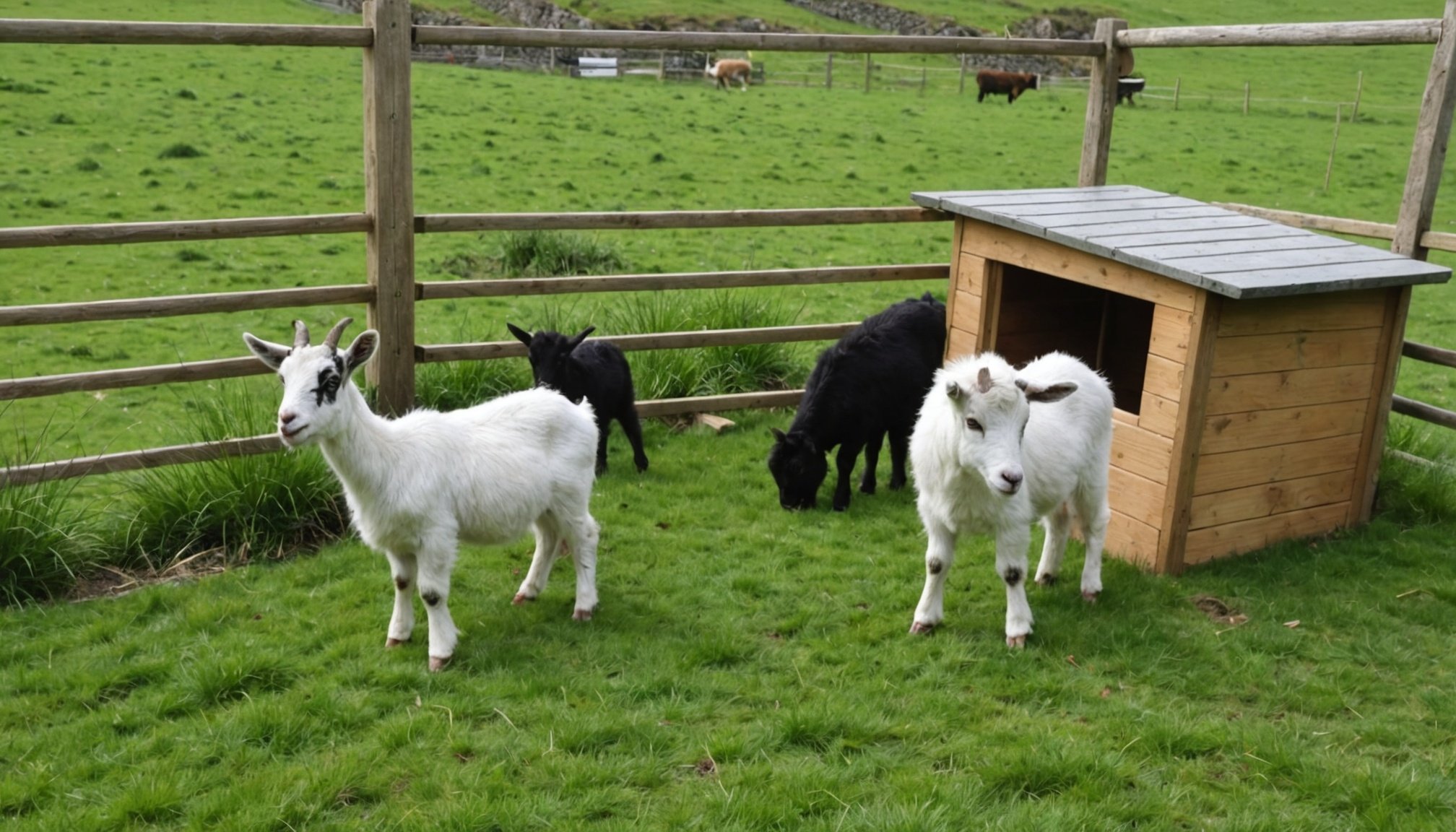Creating a secure outdoor habitat for pygmy goats in the Welsh countryside requires thoughtful planning and design. These charming animals thrive in safe environments tailored to their needs. This guide will explore essential components such as proper fencing, shelter, and enrichment activities. With a focus on practicality and sustainability, you’ll learn how to provide a nurturing space that keeps your pygmy goats healthy and happy while enhancing the beauty of your countryside life. Join us in building a thriving habitat that reflects your love for these delightful creatures.
Understanding Pygmy Goats and Their Needs
Exploring the pygmy goat care essentials reveals a fascinating world of small, lively creatures with unique needs. These goats are known for their compact size, friendly demeanor, and adaptability, making them popular as pets and livestock. However, they require specific attention to thrive.
Sujet a lire : Mastering Shedding Solutions for Siberian Huskies in the UK”s Warm Climate: Tips and Tricks
Behavioral and Social Needs
Pygmy goats are inherently social animals, often thriving in groups. They exhibit playful behaviors and enjoy interacting with humans and other goats. Ensuring they have companions is crucial for their emotional well-being. A solitary goat may experience stress, leading to health issues.
Importance of Proper Habitat
Creating an appropriate habitat is vital for the health and well-being of pygmy goats. They need a safe, spacious environment to roam and graze. A well-designed habitat should include:
Avez-vous vu cela : Mastering Shedding Solutions for Siberian Huskies in the UK”s Warm Climate: Tips and Tricks
- Shelter: Protects from weather extremes.
- Fencing: Keeps predators out and goats safe.
- Grazing area: Provides natural forage and exercise.
Proper pygmy goat care involves balancing their social and physical needs. A well-maintained environment ensures they remain healthy and active, highlighting the importance of understanding their unique requirements. By catering to these needs, owners can enjoy the companionship of these delightful animals while ensuring their well-being.
Designing an Outdoor Habitat
Creating a suitable goat habitat design is essential for the health and happiness of pygmy goats. Key considerations include ensuring safety, comfort, and space for natural behaviors.
Habitat Layout Considerations
A well-planned outdoor goat shelter should feature areas for shelter, grazing, and play. Fencing is crucial to protect goats from predators and prevent escape. Use sturdy materials to withstand the goats' curiosity and climbing tendencies. Incorporate shaded areas to shield goats from harsh weather.
Types of Shelters
Selecting the right outdoor goat shelter involves understanding the goats' needs. Options include:
- Barns: Provide comprehensive protection.
- Lean-tos: Offer simple coverage.
- Sheds: Balance protection and ventilation.
Safe Outdoor Spaces
Designing safe spaces for play and grazing is vital in goat habitat design. Ensure a variety of terrains to encourage natural foraging and exercise. Incorporate objects like logs and rocks for climbing and exploration, promoting physical and mental stimulation.
A thoughtfully designed goat habitat fosters a healthy environment where pygmy goats can thrive. By addressing these considerations, owners ensure their goats have a comfortable and secure living space, enhancing the overall well-being of these charming animals.
Essential Materials for Construction
Understanding the best goat housing materials is crucial for building a durable and cost-effective habitat. Selecting the right materials ensures a secure and comfortable environment for pygmy goats.
Recommended Materials for Goat Shelters
Wood, metal, and plastic are popular choices for constructing goat shelters. Each material offers distinct benefits:
- Wood: Provides natural insulation and is easy to work with.
- Metal: Offers durability and resistance to weather conditions.
- Plastic: Lightweight and often more affordable.
Cost-Effective and Durable Options
Balancing cost and durability is essential when selecting goat housing materials. Consider recycled or reclaimed materials to reduce expenses while maintaining quality. Metal roofing, for instance, can be a long-lasting investment despite its initial cost.
Environmental Considerations
Selecting materials with minimal environmental impact is vital. Opt for sustainably sourced wood or recycled materials to ensure eco-friendly habitat building. Additionally, consider the local climate when choosing materials to ensure the shelter remains energy efficient.
Using a combination of these goat housing materials not only supports the well-being of pygmy goats but also contributes to a sustainable and practical habitat building process. By carefully selecting materials, owners can create a safe, comfortable, and environmentally responsible living space for their goats.
Safety Measures for Pygmy Goats
Ensuring the safety of pygmy goats is paramount, particularly in areas like the Welsh countryside where predator protection is crucial. Identifying potential threats such as foxes and stray dogs is the first step in establishing effective goat safety measures.
Predator Identification and Strategies
Understanding the local wildlife is essential. Common predators in rural areas include:
- Foxes
- Stray dogs
- Birds of prey
Effective Fencing Solutions
Implementing robust fencing is a key strategy for securing the habitat. Utilize high-tensile wire or electric fences to deter predators. The fence should be at least four feet high, with a buried section to prevent digging.
Regular Maintenance Practices
Routine safety checks and maintenance are vital. Inspect fences for damage and repair promptly. Evaluate the habitat for any potential hazards like loose nails or sharp objects. Regularly updating the safety measures ensures a secure environment for the goats.
By focusing on predator protection and consistent maintenance, owners can significantly enhance the goat safety of their pygmy goats. This proactive approach not only safeguards the animals but also promotes peace of mind for their caretakers.
Climate Considerations in Wales
Understanding the Welsh climate is crucial for adapting pygmy goat habitats effectively. Wales experiences a range of seasonal weather patterns, characterized by mild, wet winters and cool, damp summers. These conditions necessitate specific adaptations to ensure the health and comfort of goats.
Modifying Habitats for Temperature and Moisture Control
Adapting goat shelters to manage temperature and moisture is essential. Insulating materials, such as straw or wood shavings, can help maintain warmth during colder months. Ventilation is equally important to prevent moisture buildup, which can lead to respiratory issues in goats.
- Insulation: Straw, wood shavings
- Ventilation: Prevents moisture buildup
- Drainage: Essential for wet conditions
Protective Measures Against Harsh Weather Conditions
Implementing protective measures is vital to safeguard goats from the harsh weather conditions that can occur in Wales. Providing windbreaks, such as hedges or fences, can reduce wind exposure. Additionally, ensuring goats have access to dry, sheltered areas during heavy rain is crucial.
"The Welsh climate demands thoughtful habitat design to ensure goat well-being."
By understanding the seasonal weather patterns and modifying habitats accordingly, goat owners can create an environment that supports the health and vitality of their pygmy goats throughout the year. This proactive approach ensures that goats remain comfortable and resilient against the challenges posed by the Welsh climate.
Legal Considerations for Goat Owners
Understanding the legal landscape is crucial for responsible goat ownership.
Overview of Local Regulations and Permits
Navigating goat ownership laws requires a comprehensive understanding of local livestock regulations. Each region may have specific requirements regarding the number of goats permitted, zoning restrictions, and necessary permits. Compliance with these regulations ensures that goat owners avoid legal issues and maintain good standing with authorities.
Key considerations include:
- Zoning laws: Determine if the area is suitable for livestock.
- Permits: Required for certain types of livestock ownership.
- Health regulations: Vaccination and health checks.
Best Practices for Compliance with Animal Welfare Laws
Adhering to animal welfare laws is essential for the ethical treatment of goats. These laws mandate proper care, including adequate shelter, nutrition, and medical attention. Regularly reviewing these regulations and implementing best practices ensures the well-being of the goats and compliance with the law.
Resources for Staying Informed About Legal Updates
Staying informed about changes in goat ownership laws and livestock regulations is vital. Resources such as local agricultural extensions, government websites, and livestock associations offer valuable information and updates. Engaging with these resources helps owners adapt to new regulations promptly, ensuring continued compliance and the welfare of their goats.
"Being informed and proactive about legal requirements is key to successful goat ownership."
Best Practices for Goat Care
Enhancing the health and happiness of pygmy goats through effective care.
Daily Care Routines and Feeding Practices
Goat care tips emphasize the importance of a consistent daily routine. Pygmy goats thrive on a schedule that includes feeding, cleaning, and health checks. A balanced diet is crucial; provide fresh hay, grains, and clean water. Incorporate minerals and vitamins to support their health.
- Hay: Primary source of nutrition
- Grains: Supplement for energy
- Water: Always fresh and plentiful
Importance of Veterinary Care and Vaccinations
Regular veterinary care is essential for maintaining pygmy goat health. Schedule routine check-ups to monitor their well-being. Vaccinations protect against common diseases, ensuring goats remain healthy. Consult with a veterinarian to establish a vaccination schedule tailored to your herd's needs.
"Preventive healthcare is key to prolonging the life of your goats."
Socialization and Companionship
Pygmy goats are social creatures, requiring interaction for emotional well-being. Encourage companionship by keeping goats in groups. Socialization reduces stress and promotes health. Engage them with toys and activities to stimulate their minds.
By adhering to these goat care tips, owners can ensure their pygmy goats lead healthy, fulfilling lives. Prioritizing daily routines, veterinary care, and socialization fosters a thriving environment for these charming animals.
Inspiration from Local Welsh Landscapes
Exploring the unique beauty of the Welsh countryside for habitat design.
Unique Features of the Welsh Landscape
The Welsh countryside offers a rich tapestry of natural elements that can inspire innovative goat habitat designs. Its rolling hills, lush valleys, and diverse plant life provide a picturesque backdrop and practical resources for goat owners. Integrating these features into goat habitats can enhance the natural environment, promoting both the goats' well-being and the aesthetic appeal of the farm.
Incorporating Natural Elements
Incorporating elements from the Welsh countryside into goat habitats involves using local flora and terrain to create a more natural setting. This can include planting native grasses and shrubs that goats can graze on, or using stones and logs from the area to build climbing structures. These additions not only enrich the goats’ environment but also help maintain the ecological balance of the region.
- Native grasses: Enhance grazing areas
- Local stones: Build climbing structures
- Natural shade: Use existing trees
Examples of Successful Local Goat Farms
Several goat farms in the Welsh countryside have successfully integrated these elements, creating thriving environments for their herds. These farms demonstrate the benefits of using local resources to design sustainable and effective goat habitats. By observing these successful examples, new goat owners can gain valuable insights into creating their own harmonious and productive farms.
Community and Support Resources
Discovering avenues for connection and learning among goat owners
Organizations and Clubs for Pygmy Goat Enthusiasts
Joining a goat owner community can greatly enhance your experience as a pygmy goat owner. Numerous organizations and clubs are dedicated to supporting enthusiasts by providing valuable resources and networking opportunities. These groups often host events and offer guidance on best practices for goat care and management.
- National Pygmy Goat Association
- Local Livestock Clubs
- Regional Goat Breeders' Associations
Online Forums and Social Media Groups
Engaging with online forums and social media groups is a fantastic way to connect with fellow goat owners. These platforms allow members to share experiences, ask questions, and offer advice. Participating in a goat owner community online can provide quick access to collective wisdom and support.
"Online communities are invaluable for real-time advice and camaraderie."
Local Workshops and Events
Attending local workshops and events is an excellent way to gain hands-on experience and knowledge. These gatherings often feature expert-led sessions on various aspects of goat care, from health management to habitat design. Networking with other enthusiasts at these events can strengthen your goat owner community ties and provide ongoing support.
By utilizing these resources, pygmy goat owners can build a robust support network, enhancing their skills and enjoyment in goat keeping.
Monitoring and Adapting Your Habitat
Ensuring a thriving environment for pygmy goats through observation and adaptation.
Techniques for Observing Goat Behavior and Health
Monitoring goat behavior is crucial for maintaining a healthy habitat. Regularly observe your goats for signs of distress, illness, or unusual activity. Key indicators include changes in eating habits, social interaction, and physical appearance. Maintaining a goat behavior observation log can help track patterns and identify issues early.
Adapting the Habitat Based on Observations
Based on your observations, make necessary adjustments to the habitat. If goats appear stressed or exhibit health issues, consider changes in shelter, space, or social dynamics. For instance, if goats are frequently escaping, enhance fencing security. Regularly updating the habitat ensures it meets the evolving needs of your goats.
- Shelter adjustments: Improve insulation or ventilation
- Space modifications: Increase grazing areas
- Social dynamics: Introduce or separate goats as needed
Importance of Ongoing Education and Resource Updates
Continual learning is vital for effective habitat monitoring. Stay informed about the latest goat care practices by attending workshops, reading publications, and engaging with the goat owner community. Access to current resources enhances your ability to adapt the habitat effectively, ensuring the well-being of your goats.
"Adaptability is key to maintaining a thriving environment for your goats."










